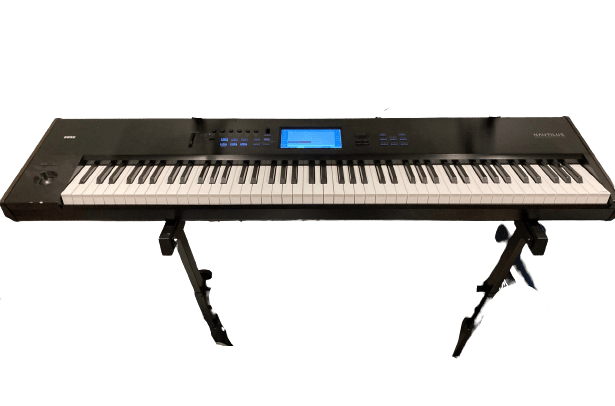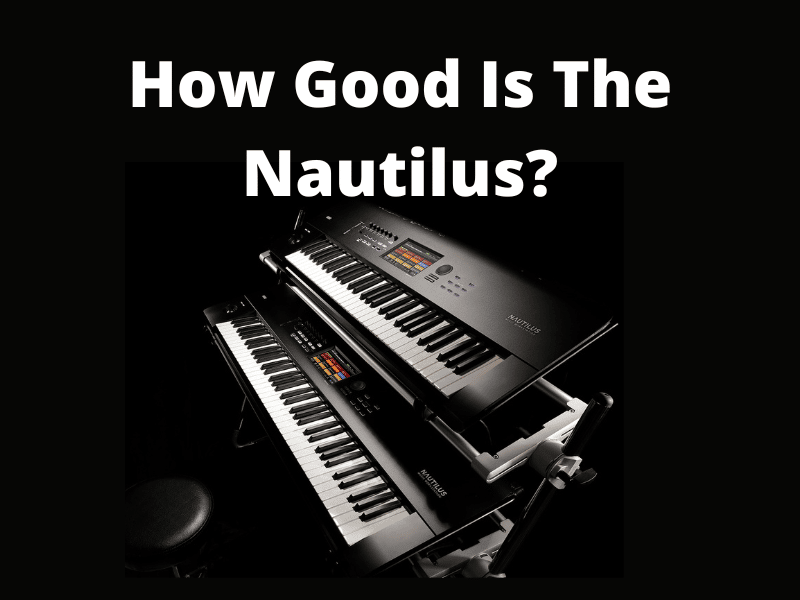*Keyboardkraze now has a nearly 24/7 chat service directly with me should you have any questions regarding keyboard/plugin choices! This is connected directly to me and it is not AI.
Table of Contents
If you’re no stranger to workstation keyboards, you have likely heard of Korg and their famous Kronos series. Korg recently released their newest workstation, the Korg Nautilus, and I had the pleasure of spending a month playing and reviewing it.
This article will break down my thoughts on the Korg Nautilus in an honest review.
Recently, great workstations have been released, and I have to say, the Nautilus has instantly become one of my favorites. The Korg Nautilus is available in 61, 73, and 88 keys, with the 61 and 73 versions having a different keybed.
The Korg Nautilus is a successful streamlined version of the iconic Kronos. This workstation is affordable, yet still capable of doing many things we've all loved with the Kronos. On top of this, the sounds vary from the Kronos.
Korg’s goal with the Nautilus was to make a streamlined, affordable, yet powerful machine similar to the Kronos.
Note* The first workstation I purchased was the Roland G8 about 15 years ago. While it was an excellent keyboard, it was more expensive than the Nautilus today, which is crazy.
So, did they achieve to do so? I believe they did in a significant way.
Korg Nautilus 88 Overview

At first glance, the Nautilus checks all the boxes for what I would expect from a workstation: a sleek modern design, LCD touchscreen, solid key-action, and an impressive number of presets/effects.
Interestingly, when I opened it, I first thought that it resembled the Kronos, which I think is a positive, seeing how popular and iconic the Kronos series has been.
One of the main things that will attract many is the affordable price tag considering everything you get with a workstation like the Nautilus. In years past, this would run you easily double the price.
I had read a lot of forums before getting the Nautilus in which pianists compared it to the Kronos. If you’re a fan of the Kronos, you will love the Nautilus, especially for the price.
Korg has streamlined the Kronos into a powerful, affordable, and accessible machine to use: meet the Nautilus.
I believe the Nautilus excels in the sound department. Within my first twenty minutes of playing the Nautilus, I enjoyed the pianos and synth leads, with some of the sounds surprising. While I will dive deeper into this later, the sounds were completely different than the Kronos, making this the most vital selling point of the Nautilus.
As a pianist who utilizes VSTs typically for my piano sounds, I have to say, the Korg Nautilus measures up against some of the best piano VSTs on the market.
Pros
- Incredible key-action
- Beautiful piano sounds
- Over 2,500 presets
- Great price
- Streamlined for gigs and easier to use for beginners
- Impressive bundled software included with purchase
- Useful reverb built-in
- Touch-screen
Cons
- Keys lack aftertouch
- Long boot time (takes about two minutes to load)
Features
Let’s take a look at the features and specs of the Korg Nautilus:
- Nine onboard sound engines (Kronos)
- Updated SGX-2 and HD-1 engine for brand new sounds
- Impressive dynamic knobs
- Touchview interface
- Setlist mode for live performances
- Open sampling system
- 16-track MIDI sequencer / 16-track audio recorder
- 16 onboard effect processors
- Up to 14 simultaneous effects and 32 simultaneous EQs for massive production power
- Can change sounds without losing the current patch sound
Specs

- Keybed: Korg RH3 key-bed
- Polyphony: 140 note
- Presets: 2500+ presets
- Effects: 197 effects, including beautiful reverb
- Effect type: EQ, Overdrive, Modulation, Delay, Reverb
- Arpeggiator: Yes
- Sequencer: 16-track sequencer
- Audio Inputs:2 x 1/4″
- Audio Outputs:2 x 1/4″ (R, L/Mono), 4 x 1/4″
- Headphones:1 x 1/4″
- Height:5.47″
- Width:56.57″
- Depth:15.24″
- Weight:50.93 lbs.
For a complete list of the specs, you can also view Korg’s spec page here:
Given the slim and sleek design, I expected the weight to be a bit lighter, but I also understand that workstations are typically heavier.
Let’s take a look at my favorite specs below in more detail.
Key-Action

The RH-3 keybed is the same keybed found on the Kronos. While I’ve played the Kronos many times, it was refreshing to play the Nautilus. The keys feel excellent and responsive in ways you want/expect.
Overall, the weight of the keys is on point. They’re not too heavy or light, and I would say they lean a little more on the heavier side, which I prefer.
Being able to adjust the dynamic knobs is a significant plus. This allows you to enhance when you’re playing soft or loud.
While I will praise the key action, there is, unfortunately, a downside. The Nautilus lacks aftertouch, which, if you’re someone who likes to utilize synthesizers, you might find this upsetting.
Design

The design is very similar to the Kronos, with both keyboards weighing nearly 50 lbs. Korg decided to go with one wheel with the Nautilus, which I’m totally fine with.
In terms of layout, everything was where I would expect it. The LCD screen makes navigation a breeze and has always been an area I prefer over the standard turning of wheels/knobs to navigate.
Navigation is quite easy, whether designing a set, exploring new sounds, or laying down sequences.
Sounds

The most vital aspect of the Nautilus is, without a doubt, the sound. The Nautilus packs crisp pianos with ripping basses, soothing acoustic guitars, lush synths, and complex organs. You also have a bunch of control over each sound so that you can bend and manipulate patches to your liking, making a sound designer’s dream.
Pianos
My favorite part of the Nautilus is arguably the piano sounds. I immediately fell in love with a couple of presets: the classic first patch, the upright piano, and the Italian Grand.
The pianos sound rich and colorful, especially in the mids and lower register, which is crucial for me.
In order to get the tones, Korg features an updated version of the SGX-2 piano sound generator, leveraging 12-step velocity switching, sympathetic string resonance, and variable ambiance.
I’ve been throwing a touch of reverb on most piano sounds and dialing it in from there. If you’re someone who utilizes piano sounds, you will be happy with the Nautilus.
Guitars
The guitar sounds are a step above most other keyboard guitar sounds I have heard, especially the acoustic guitars. You can dive deep and really develop some cool tones with the acoustic guitars.
Electric Pianos
The electric pianos are superb—some gritty electric pianos, as well as some soft yet deep sounds as well. I’m one to use electric pianos heavily throughout my set, so having access to great-sounding options is a must.
Synths
The synth department surprised me. I’m used to workstation sounds coming off as dated as of late, especially with the VST craze going on. I think Korg did a great job providing some fantastic leads, as well as some beautiful pads.
Organs
Countless organs sound fantastic on the Nautilus. Utilizing the effects department and knobs is a must for some of these organs.
Basses
The basses on the Nautilus caught me off guard. There is a P-Bass that has some crazy realism to it, especially when sending it through an amp or set of nice speakers. If you’re a fan of electronic music, you will really love the synth basses as well as there are a few that are out of this world.
Connectivity

Korg gives you everything you would expect when it comes to connections with this workstation. The back of the Nautilus features:
- six audio outputs
- three MIDI DIN sockets
- three foot pedal ins
- Two audio inputs
- Two USB ports
Sampling
The sampling on the Nautilus is better than I had expected. When workstations first had this feature, it took forever and was often very sloppy. It’s come a long way, and it’s great to have the ability to sample an external audio source of your liking quickly.
You can also use sounds or samples you’ve made on your laptop/mac directly on your Nautilus.
Worth The Purchase?
If you’re looking for a workstation near the $2,000 price point, I recommend the Nautilus. If you love to dive deep into sounds and drums, you will have a fantastic time.
VS The FA 08
Full disclosure: I have owned the FA08 for many years, and this is the keyboard I use as a MIDI controller in my live rig. That being said, I believe the Nautilus wins in every department over the FA 08, outside of using it as a MIDI controller.
VS The Yamaha MODX
Compared to the Yamaha MODX, I prefer the sounds of the Nautilus. However, I also believe you can do more should you be using your workstation to record rather than a DAW.
I’ll always prefer Korg and Roland keys in the keys department over Yamaha. They should feel a little more realistic, in my opinion.
The area where the MODX could be more convenient could be with touring, as the MODX is a lot lighter than the Nautilus.
VS The Kronos
The Nautilus is drawing many comparisons to the Kronos and for good reason: they are very similar. The main feature that Korg users could miss with the Nautilus is the lack of Karma. Outside of this, I found myself enjoying some of the presets more on the Nautilus than the Kronos.
If you’re trying to decide on which to purchase between the Kronos and the Nautilus, I would push you towards the Nautilus as I believe Korg will be releasing another Kronos in the near future.
Alternatives To The Korg Nautilus
I believe near this price point, there’s only one other workstation I would recommend, and that would be the Kurzweil K2700.
Keyboardkraze Overall Thoughts On The Nautilus
The Nautilus is a refreshing look at a modern workstation keyboard. Korg has focused on providing keyboardists with ultimate control, from key action to sound creation, ending in a significant win for Korg and your wallet.









3 comments
dont fotgate Roland integra 7 saund modul
How come You measure Kurzweil K2700 with Korg Nautilus, although later has (from pianistic point of view) better key action and piano sounds, more sound engines, much more storage space for samples/sounds? What’s more, You gave an “5” to K2700, and “only” 4.5 to Nautilus. To my knowledge, only department that K2700 excels in is MIDI control (knobs, and sliders and ribbon).
Would You be willing to give us more insight to Your preferences?
Hi Josko
Thanks for the comment. So I have the K2700 and the Nautilus both in my studio. I end up playing the K2700 far more than the Nautilus. For whatever reason, I enjoy the sounds of the K2700 far more, as well as the key action. I also do use a lot of VSTs, but when I’m writing, I usually end up on the K2700.
All of guitars/bass sounds of the K2700 are fantastic IMO and I actually wrote one of the guitar parts for one of Vinyl Theatre’s songs on the K2700.
Kind regards,
Chris